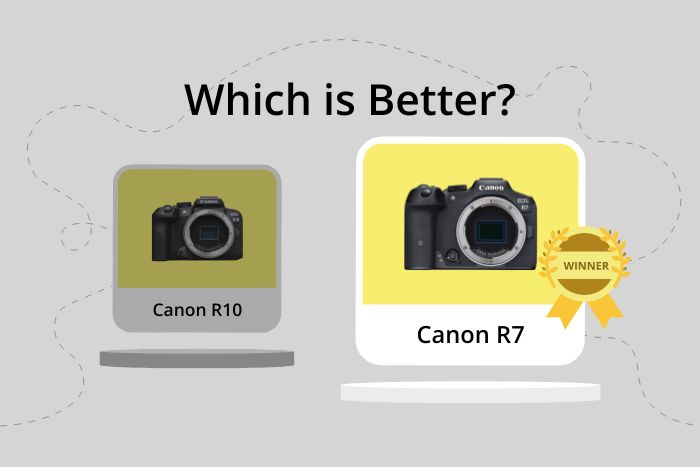Canon EOS R10 vs EOS R7 Comparison
Canon EOS R10
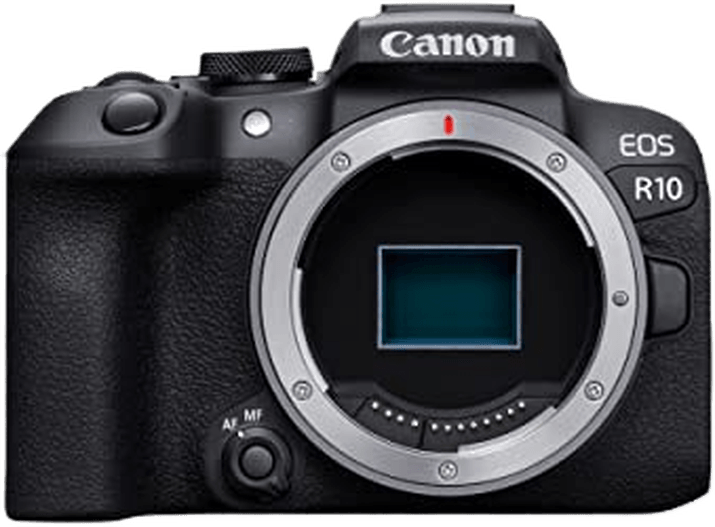
Canon EOS R7
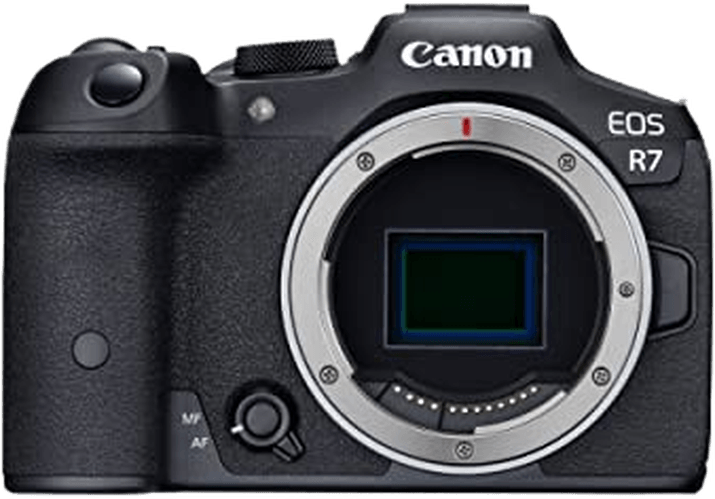
Canon R7 vs R10 Overview
This comparison has two Canon cameras going head-to-head. It’s the Canon R7 vs R10. They’re both new cameras in Canon’s classic EOS range. And both were released in May 2022.
Sourcing the cameras has been tricky because they’re so new. And the Canon EOS R7 has been plagued with supply issues. That means this comparison will be a specs vs specs examination.
Body and Handling
Canon EOS cameras have a reputation for good handling. And these two cameras continue that trend. They have an ergonomic design and handle well.
The Canon EOS R7 is the heavier of the two camera bodies. The camera is 0.40 lb (200 g) heavier than the EOS R10. And the R7 is also slightly larger in every dimension.
At 0.94 (426 g) and 1.35 lb (612 g), they are about average weight for mirrorless cameras. And the bodies are smaller than many of their DSLR cousins in the EOS collection.
We’re happy to see both Canon cameras have weather-sealed bodies. That gives you more freedom to shoot outdoors. And it’s good news for sports and wildlife photography.
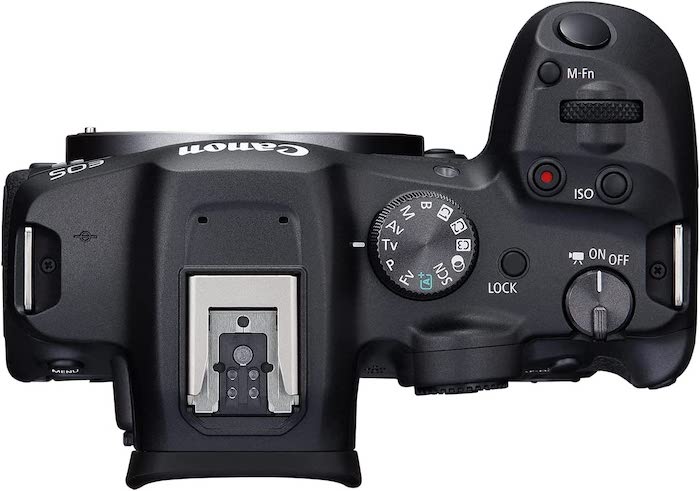
Optics
Now we’ll see how these Canon EOS cameras compare when it comes to image creation. We’ll tell you which mirrorless camera gives you more bang for your buck in the photography department.
Sensor and Resolution
The Canon EOS R7 and EOS R10 both have APS-C sensors. The EOS R10 gives you a healthy megapixel count of 20 MP, which is fairly standard for an APS-C camera. But the EOS R7 trumps it by quite some distance.
The Canon EOS R7 gives you an impressive 33 MP from the APS-C sensor. That’s powerful for a sensor of this size, and a number you’re more likely to see in a full frame sensor.

Canon EOS R7
The increased MP count gives the EOS R7 a higher image resolution. The EOS R10 has an image resolution of 6000 x 4000 pixels. While that is excellent image quality, the EOS R7 beats it with an image resolution of 6960 x 4640 pixels. That’s professional-level image quality you don’t often see in APS-C cameras.
Low-Light Performance
There’s very little to separate the two when it comes to low-light performance. The Canon EOS R7 and R10 have an ISO range from 100 to 32,000. And these can be expanded to 51,200 if needed. That gives you plenty of low-light shooting options.
The Canon EOS R7 only pulls ahead in low light performance when we get to video specs. The EOS R7 utilizes the full ISO range for video recording. But the Canon EOS R10 maxes out at ISO 25,600 for videos.
The higher sensor resolution of the EOS R7 means you get a better dynamic range from that camera.
Image Stabilization
The Canon EOS R7 beats the EOS R10 for image stabilization. The Canon EOS R10 only has lens stabilization when available with compatible lenses. The EOS R7 has in-body image stabilization. The Sensor Shift stabilization gives you up to 7 stops of shake reduction, which is fantastic if you shoot handheld.
The Canon EOS R7 is a higher level camera, so stabilization is expected. But it’s disappointing not to see something similar in the Canon EOS R10.
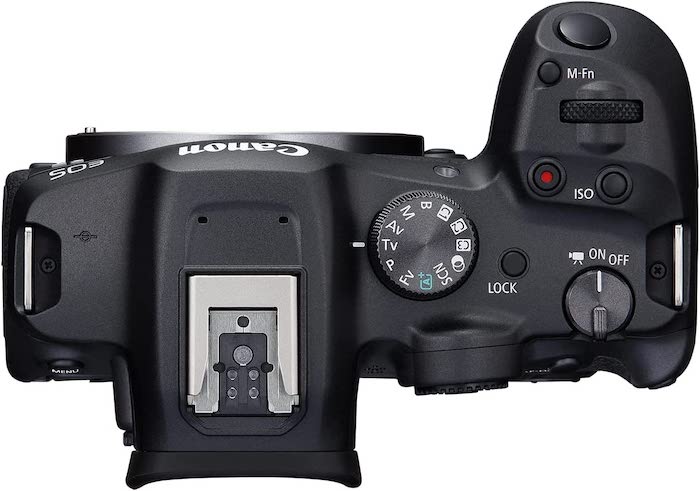
Canon RF Lenses
The Canon EOS R10 and EOS R7 have an RF lens mount. The Canon RF lenses aren’t as plentiful and varied as their EF range. But the catalog has been growing steadily over the past few years.
The RF interchangeable lenses were receiving some backlash due to the heavy price tags. But Canon has introduced more budget-friendly options. And the RF range has a good selection of lenses for all photographers.
Canon EOS R10 vs EOS R7 Video Performance
Modern photographers expect good video features from new mirrorless cameras. These two cameras have good video features. They are both true hybrid cameras that deliver video and photography.
We’ve already seen the R7’s higher ISO range in video mode. But other than that, there aren’t many stand-out differences in the video department.
They have 4K video capabilities. And they both have the option for shooting at 30 or 60 fps at 4K. That’s impressive video quality with a super-smooth frame rate. You can create professional videos with the Canon EOS R10 and R7.
The Canon EOS R7 tops the EOS R10 at higher frame rates. The R10 can record Full HD at 100 fps. But the R7 has Full HD at 120 fps. That’ll give you fantastic slow-motion footage.
The EOS R7’s image stabilization will also improve the video quality, especially when shooting handheld. You might need a tripod or gimbal more often if you’re shooting video with the Canon EOS R10.
Canon EOS R10 vs EOS R7 Features and Benefits
Now we’ll compare the main features of the Canon EOS R7 and R10. We’ll see some similarities. But there are plenty of differences to set these two cameras apart.
Viewfinder
Both cameras have electronic viewfinders. That’s no surprise for mirrorless cameras. But it is surprising to see they both have identical viewfinders. One might expect more considering the higher price of the EOS R7.
They have a 0.39-inch OLED color EVF with a 2.36 million dot resolution (1024 x 768). That’s a decent resolution compared to competitors. But it’s nothing groundbreaking.
Autofocus System
The Canon EOS R10 and R7 use the same autofocus system, and it’s a highlight of both cameras.
It’s a Dual Pixel CMOS AF II system. It uses 651 focus points, giving you 100% coverage across the frame. It has face and eye detection and tracking. And that works with animals too. It also locks and tracks focus when photographing moving vehicles.
It’s a sophisticated autofocus system. And photographers in many different areas of photography will appreciate the quality of the AF system. It’s perfect for wildlife and sports photography. And it’ll make street photography easier too.
Continuous Shooting
They both have a respectable max continuous shooting speed of 15 fps with the mechanical shutter. But both cameras have a faster burst rate if you switch to the electronic shutter.
The Canon EOS R10 has a burst rate of 23 fps with the electronic shutter. And the EOS R7 has a rate of 30 fps. That’s fantastic for fast action, and sports photographers will love it.
We see another difference in buffering capabilities. The EOS R10 can buffer 70 JPEG images with the electronic shutter. But in RAW burst mode, the limit is 21 RAW images.
The Canon EOS R7 can buffer 126 JPEG and 41 RAW images using the electronic shutter. That’ll make a big difference to professional sports photographers.
LCD Screen
Both cameras have a 3-inch vari-angle touchscreen. They have a good range of movement, which helps get those tricky shots.
There’s a big difference in screen resolution. The Canon EOS R10 has a 1.40 million dot screen resolution. That’s very healthy for an APS-C camera. But the Canon EOS R7 has an impressive 1.62 million dots, giving the screen incredible resolution.
Flash
Only the EOS R10 has a built-in flash. That’s a handy feature for night shooters. The EOS R7 does not have a built-in flash. But both cameras do have a hotshoe connection for external flashes.
Wireless Connectivity
Wireless connectivity is a feature in both cameras. You would expect that from most modern digital cameras. And we’re happy to see the EOS R10 and R7 have Wi-Fi and Bluetooth connectivity. That makes it easy to transfer and share media with other devices.
Canon EOS R10 vs EOS R7 Storage and Battery
Storage
The Canon EOS R7 wins the battle of storage. They both have good memory card compatibility (SD, SDHC, and SDXC). But the Canon EOS R10 only has a single SD card slot. The EOS R7 has dual card slots for added storage. It’s a feature that busy photographers will appreciate.
Battery Life
The LP-E6NH battery of the R7 outperforms the LP-E17 battery of the R10. The EOS R10 has a 450-shot battery life. And while that’s strong for a mirrorless camera, you get 660 shots from the Canon EOS R7. That’s impressive considering the power of the sensor.
USB charging is another feature we’re pleased to see in both Canon models. That makes it easier to recharge when you’re on the move.
Canon EOS R10 vs EOS R7 – Our Verdict
The Canon EOS R7 takes the crown in the battle between the Canon R7 vs R10. They are both excellent mirrorless cameras. But the EOS R7 outperforms the EOS R10 in some crucial areas.

Canon EOS R7
They both have APS-C sensors. But the Canon EOS R7 is miles ahead with an image resolution of 33 MP. That’s impressive by any comparison in the mirrorless camera division. It also has other features enthusiasts and professional photographers will appreciate.
You have the dual SD card slots and better battery life. There’s the better burst mode and higher ISO with video. The Canon EOS R10 has excellent features. But the EOS R7 has even better features.
While the EOS R7 is today’s winner, other elements need to be considered. The R7 is more expensive, so you’re paying for the better features. And the EOS R10 is aimed at an audience with a lower skill level. The Canon EOS R10 is a fantastic mirrorless option for beginners and enthusiasts. But if you have more experience, the Canon EOS R7 is worth the extra cost.

